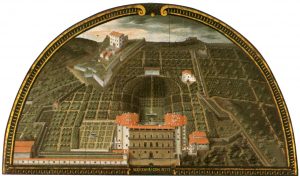
“It is said that Piero de’ Medici, who had long associated with Michelangelo, often sent for him, wishing to buy antique cameos and other intaglios, and one snowy winter he got him to make a beautiful snow statue in the court of his palace. He so honoured Michelangelo for his ability that his father [Lorenzo de’ Medici], seeing him in such favour with the great, clothed him much more sumptuously than before.”
– Giorgio Vasari, Lives of the Most Eminent Painters, Sculptors and Architects –
Around 600 years ago, while the dusk was setting on the dark ages, Florence was at the dawn of one of the most industrious periods the arts and sciences had ever seen. At the Hands of the Medici Family, Florence and Rome saw some of the most recognisable names produce some of the most lasting works of art and architecture under the Patronage of the Medici. Brunelleschi’s Dome, Botticelli’s Birth of Venus, Michelangelo’s David, Raphael’s The School of Athens, Leonardo’s Annunciation, Vassari’s The Lifes of the Artists are but a few of the immortal works that came from renaissance Italy.
Within the space of 200 years, the Medici family grew from merchants to bankers to popes to rulers; built palaces adorned by frescos and lined with marble sculptures, had their children taught by Gallileo, adopted the young Michelangelo, and established the first ever school of arts. It was a time of extremes, strained by good and evil, beast and beauty, extermination and genesis, death and rebirth.
It is hard to imagine there will be another period like it. Is it possible that within the challenges of the globalised world that we live in we will see another rise of such ruthless vision and uncompromising creativity? Will we see another cultural revolution of such magnitude… and what would it be a revolution of? Throughout history we have had great patrons of the arts and architecture. During the industrial age there was a surge of privately funded mega-projects, especially in the US. From the Rockefellers in New York, Adolph Sutro in San Francisco to Andrew Carnegie, who built 2,509 public libraries across America, Canada and Great Britain.
Now we have the technology moguls and their foundations, investing vast sums of money in social and community based projects that are vastly different in nature to the ones set out before them. It’s unlikely that in 100 years time we will read about the vandalism to an affordable home built with ‘Gates money’. What these philanthropists will leave is not so much a built legacy comparable to that of the Rockefeller and the Medici family, but a community legacy. It is no secret that what the Medici ultimately sought was political supremacy and that art was a tool to communicate that supremacy to the citizens. There is no denying however, that standing in the Basilica of San Lorenzo, despite it’s immoral history and motivations, is enough to make one forget the sufferings of the past, and perhaps for a moment glance over the sufferings of the future.
What can we learn from the good and evil of a time and place where salvation was sold to peasants by the Pope in return for a paper receipt in order to clear his debt from abundant spending, and when people lined the streets to wildly cheer the laying of the final bricks on a dome that would become the sacred heart of their city.
Unit 18 will look into the themes of patronage. Students will be asked to choose a patron for the year. He or she may be real or fictional, historic or contemporary. You will travel to Florence to see the fruit of the creative caldron of the renaissance that dominates the city to this day. Is it conceivable that any work of art or building will be as celebrated in 600 years time as Brunelleschi’s Dome and Michelangelo’s Papal Frescos are now?
“The Medici made me and the Medici destroyed me.”
– Leonardo da Vinci –